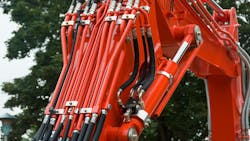From the Editor's Desk: Is the Fluid Power Industry Headed for Recovery in 2026?
Last week I attended the National Fluid Power Association's (NFPA) Industry & Economic Outlook Conference (IEOC) which once again provided insights into the current state of the global economy as well the fluid power industry and its various customer markets.
This annual event is always well attended due to the data and forecasts offered by the economists NFPA brings in to present which helps many shape their business plans for the coming year. After a difficult 2024 for the hydraulics and pneumatics industry, as well as not so stellar 2025 to date, this kind of information is even more critical. Eric Lanke, President & CEO of NFPA, said over 240 people registered to attend the 2025 edition of the IEOC, which was another strong showing for the event — and demonstrates the value of the information provided during it to fluid power industry members.
Understanding how various markets are expected to perform can help fluid power companies better direct both their sales and design efforts to meet the needs of those markets for which they see the most opportunities.
What's in Store for Fluid Power in 2026?
In general, it looks to be a bit of a mixed bag going forward into 2026 regarding how the economy and various market sectors will perform. While some of the presenters at the NFPA IEOC see a recovery ahead for some markets, others seemed less certain.
The fluid power industry itself has seen some signs of life as of late, particularly for pneumatics and industrial hydraulics, as activity in the industrial sector has been better than that in the mobile equipment market. Connar Lokar of ITR Economics said during his IEOC presentation that it appears fluid power shipments are recovering and growth is coming in 2026, aided by some recovery in various global markets such as agriculture which is seeing its pace of decline slowing.
Jim Meil of ACT Research also noted there may be a rebound for the hydraulics and pneumatics industry in 2026 but it will be modest compared to the downturn the sector has experienced over the last few years.
Two of the largest customer segments for fluid power, construction equipment and agricultural machinery, are not expected to see huge improvements in the coming year, which is a factor for the more muted fluid power forecast in 2026. Construction activity is anticipated to be sluggish, keeping equipment demand low. However, the current boom in data centers could be one of the few opportunity areas for the sector as a number of construction machines are required to build these facilities.
Weak row crop prices are among the factors challenging the agricultural equipment industry. If these improve in 2026, there could be some improved purchasing activity in this sector which would benefit the fluid power industry as well.
Industrial machinery started 2025 on a better note, benefiting the pneumatics and industrial hydraulics segments of the fluid power industry, but that activity has since slowed some. It was noted by some presenters that some of this positivity in the first half of the year could be due to companies trying to make purchases ahead of tariffs going into effect.
Continued uncertainty related to tariffs and interest rates has kept business investments lower, and will likely remain the case until some clarity is provided on each. There is talk of interest rates being lowered later this year, but when and how much remains to be seen; it is likely rates will be lowered only a small percentage as long as inflation remains high. But some easing in rates, as well as any final decisions made on tariffs could help alleviate the uncertainty felt by many as they can then better plan business decisions.
Watch our video discussion below with other editors from EndeavorB2B to learn how tariffs have impacted those in the fluid power, electronics and broader manufacturing industries.
The recently passed One Big Beautiful Bill may help alleviate costs for manufacturers as well given the tax breaks and equipment purchasing incentives included in it which could benefit the industrial machinery sector and the fluid power suppliers serving it.
Read more about the potential impacts of the One Big Beautiful Bill Act on various industries in the following articles from other EndeavorB2B publications.
Trump’s ‘One Big Beautiful Bill’ passes, trucking orgs have mixed feelings from FleetOwner
Now Signed Into Law, Here's What the One Big Beautiful Bill Means for Home Builders from ProBuilder
One Big Beautiful Bill Act provides certainty for J&J’s $55B US manufacturing investment from Pharma Manufacturing
“One Big Beautiful Bill Act” Passage Leads AT&T to Accelerate Fiber Infrastructure Plans from Cabling Installation & Maintenance
Pharmaceuticals and food production are among the opportunity areas for this segment in the years to come as the need for both grows. While the U.S. pharmaceutical sector does have concerns about tariffs on ingredients it imports from China and India, several companies in the industry have announced plans to build up domestic production. If those pan out, it will aid growth for this market and the various industries supplying it including fluid power.
Although the forecsts presented during the NFPA IEOC 2025 did not indicte it will be a boom market for the fluid power industry and its customer markets in the year to come, it was not all doom and gloom either. There are opportunity areas and some growth anticipated in the years ahead for which the industry should prepare itself to meet.
Stay tuned for future coverage of the opportunity areas ahead as well as our annual State of the Industry coverage later this year for deeper insights into the forecasted performance of the hydraulics and pneumatics industry as well as the markets it serves.
What has your experience been so far in 2025? What, if any, market challenges have you seen impact the company you work at or the fluid power industry as a whole? Do you anticipate improved market conditions in 2026? Take our brief survey below to offer your thoughts or send me an email at [email protected] to let me know what market challenges and opportunities you see for the fluid power sector in the year to come.
About the Author
Sara Jensen
Executive Editor, Power & Motion
Sara Jensen is executive editor of Power & Motion, directing expanded coverage into the modern fluid power space, as well as mechatronic and smart technologies. She has over 15 years of publishing experience. Prior to Power & Motion she spent 11 years with a trade publication for engineers of heavy-duty equipment, the last 3 of which were as the editor and brand lead. Over the course of her time in the B2B industry, Sara has gained an extensive knowledge of various heavy-duty equipment industries — including construction, agriculture, mining and on-road trucks —along with the systems and market trends which impact them such as fluid power and electronic motion control technologies.
You can follow Sara and Power & Motion via the following social media handles:
X (formerly Twitter): @TechnlgyEditor and @PowerMotionTech
LinkedIn: @SaraJensen and @Power&Motion
Facebook: @PowerMotionTech

Leaders relevant to this article:


